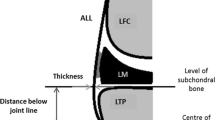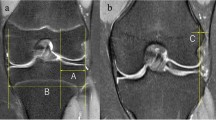Abstract
Purpose
To compare magnetic resonance (MR) signal intensity in the medial meniscus at the time of displacement and after its reduction in patients with a displaced bucket-handle tear of the meniscus associated with anterior cruciate ligament (ACL) injury.
Methods
Nine chronic ACL-deficient patients (3 male, 6 female, mean age 29 years) with locking due to a displaced fragment of the medial meniscus following a bucket-handle tear were involved in this study. In all patients, the following two-stage surgeries were planned as follows: first operation, arthroscopic reduction of the meniscus; second operation, meniscal repair and ACL reconstruction after immobilization for 1–2 weeks. Magnetic resonance imaging (MRI) evaluation using coronal T2*-weighted images was performed when the knee was locked and after the meniscus was reduced. Signal intensity before and after meniscal reduction was compared in the same patients.
Results
In 8 of the 9 patients, the displaced fragment exhibited high signal intensity in 1 patient and mildly high in 7 patients. After its reduction, the signal intensity changed to low in all 8 patients.
Conclusions
A high-intensity signal in the displaced fragment of the medial meniscus may change to low after its reduction to its original position. Therefore, at the time of decision-making regarding meniscus repair for a displaced meniscus in a locked knee, surgeons should give priority to arthroscopic findings rather than to signal intensity on MRI.
Level of evidence
Diagnostic study, Level III.

Similar content being viewed by others
References
Cannon WD Jr (1993) Problems of the menisci and their treatment, In: Larson RL, Grana WA eds The knee: form, function, pathology, and treatment. WB Saunders, Philadelphia pp. 429-469
Crema MD, Hunter DJ, Roemer FW, Li L, Marra MD, Nogueira-Barbosa MH, Le Graverand MP, Wyman BT, Guermazi A (2011) The relationship between prevalent medial meniscal intrasubstance signal changes and incident medial meniscal tears in women over a 1-year period assessed with 3.0 T MRI. Skeletal Radiol 40:1017–1023
Crues JV 3rd, Mink J, Levy TL, Lotysch M, Stoller DW (1987) Meniscal tears of the knee: accuracy of MR imaging. Radiology 164:445–448
Helms CA, Laorr A, Cannon WD Jr (1998) The absent bow tie sign in bucket-handle tears of the menisci in the knee. Am J Roentgenol 170:57–61
Matsui T, Hamada M, Tagawa Y, Yoneda K, Miyama T, Kawai H (2010) Displaced bucket-handle tear of the medial meniscus—is MRI useful for predicting reparability? J Jpn Orthop Knee Arthrosc Sports Med. 35:556–559 (in Japanese)
Miao Y, Yu JK, Ao YF, Zheng ZZ, Gong X, Leung KK (2011) Diagnostic values of 3 methods for evaluating meniscal healing status after meniscal repair: comparison among second-look arthroscopy, clinical assessment, and magnetic resonance imaging. Am J Sports Med 39:735–742
Nourissat G, Beaufils P, Charrois O, Selmi TA, Thoreux P, Moyen B, Cassard X (2008) Magnetic resonance imaging as a tool to predict reparability of longitudinal full-thickness meniscus lesions. Knee Surg Sports Traumatol Arthrosc 16:482–486
O’Shea JJ, Shelbourne KD (2003) Repair of locked bucket-handle meniscal tears in knees with chronic anterior cruciate ligament deficiency. Am J Sports Med 31:216–220
Peterfy CG, Janzen DL, Tirman PF, van Dijke CF, Pollack M, Genant HK (1994) “Magic-angle” phenomenon: a cause of increased signal in the normal lateral meniscus on short-TE MR images of the knee. Am J Roentgenol 163:149–154
Stoller DW, Martin C, Crues JV 3rd, Kaplan L, Mink JH (1987) Meniscal tears: pathologic correlation with MR imaging. Radiology 163:731–735
Thoreux P, Réty F, Nourissat G, Rivière X, Safa P, Durand S, Masquelet AC (2006) Bucket-handle meniscal lesions: magnetic resonance imaging criteria for reparability. Arthroscopy 22:954–961
Watt AJ, Halliday T, Raby N (2000) The value of the absent bow tie sign in MRI of bucket-handle tears. Clin Radiol 55:622–626
Weiss KL, Morehouse HT, Levy IM (1991) Sagittal MR images of the knee: a low-signal band parallel to the posterior cruciate ligament caused by a displaced bucket-handle tear. Am J Roentgenol 156:117–119
Yoo WJ, Lee K, Moon HJ, Shin CH, Cho TJ, Choi IH, Cheon JE (2012) Meniscal morphologic changes on magnetic resonance imaging are associated with symptomatic discoid lateral meniscal tear in children. Arthroscopy 28:330–336
Author information
Authors and Affiliations
Corresponding author
Rights and permissions
About this article
Cite this article
Hamada, M., Matsui, T., Kinugasa, K. et al. Change of signal intensity in the displaced medial meniscus after its reduction on MRI. Knee Surg Sports Traumatol Arthrosc 21, 736–739 (2013). https://doi.org/10.1007/s00167-012-2078-3
Received:
Accepted:
Published:
Issue Date:
DOI: https://doi.org/10.1007/s00167-012-2078-3




